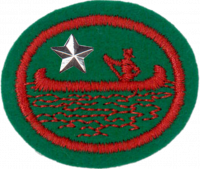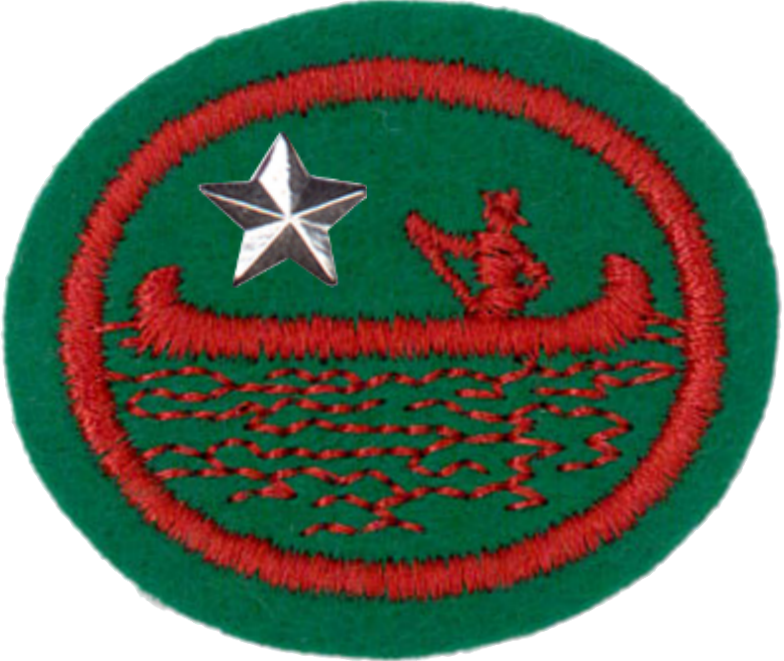Difference between revisions of "AY Honors/Canoeing - Advanced/Answer Key/es"
From Pathfinder Wiki
< AY Honors | Canoeing - AdvancedAY Honors/Canoeing - Advanced/Answer Key/es
(Created page with "</noinclude> <!-- 4. Hacer una lista de los equipos de grupo necesarios para el viaje. --> <noinclude>") |
|||
| (19 intermediate revisions by 2 users not shown) | |||
| Line 1: | Line 1: | ||
| − | + | {{HonorSubpage}} | |
| − | |||
| − | {{ | ||
| − | |||
| − | |||
| − | |||
| − | |||
| − | |||
| − | |||
| − | |||
| − | |||
| − | |||
| − | |||
<section begin="Body" /> | <section begin="Body" /> | ||
| − | {{ansreq|page={{#titleparts:{{PAGENAME}}|2|1}}|num=Note}} | + | {{ansreq|page={{#titleparts:{{PAGENAME}}|2|1}}|num=Note|dispreq=''*''}} |
<noinclude></noinclude> | <noinclude></noinclude> | ||
<!-- NOTA: Revise con su asociación/unión/división local para un seguro que puede ser necesario antes de embarca en estos viajes. --> | <!-- NOTA: Revise con su asociación/unión/división local para un seguro que puede ser necesario antes de embarca en estos viajes. --> | ||
| Line 22: | Line 10: | ||
<noinclude></noinclude> | <noinclude></noinclude> | ||
<!-- 1. Tener la especialidad de Canotaje. --> | <!-- 1. Tener la especialidad de Canotaje. --> | ||
| − | {{honor_prerequisite | + | {{honor_prerequisite|honor=Canoeing|displayname=Canotaje}} |
<noinclude></noinclude> | <noinclude></noinclude> | ||
| Line 69: | Line 57: | ||
{{ansreq|page={{#titleparts:{{PAGENAME}}|2|1}}|num=5}} | {{ansreq|page={{#titleparts:{{PAGENAME}}|2|1}}|num=5}} | ||
<noinclude></noinclude> | <noinclude></noinclude> | ||
| − | <!-- 5. | + | <!-- 5. Hacer una lista de los equipos de emergencia necesarios para el viaje. --> |
| − | |||
<noinclude></noinclude> | <noinclude></noinclude> | ||
{{CloseReq}} <!-- 5 --> | {{CloseReq}} <!-- 5 --> | ||
{{ansreq|page={{#titleparts:{{PAGENAME}}|2|1}}|num=6}} | {{ansreq|page={{#titleparts:{{PAGENAME}}|2|1}}|num=6}} | ||
<noinclude></noinclude> | <noinclude></noinclude> | ||
| − | <!-- 6. | + | <!-- 6. Hacer un equipo personal de primeros auxilios. --> |
| − | |||
| − | |||
| − | |||
| − | |||
| − | |||
| − | |||
| − | |||
<noinclude></noinclude> | <noinclude></noinclude> | ||
| Line 88: | Line 68: | ||
{{ansreq|page={{#titleparts:{{PAGENAME}}|2|1}}|num=7}} | {{ansreq|page={{#titleparts:{{PAGENAME}}|2|1}}|num=7}} | ||
<noinclude></noinclude> | <noinclude></noinclude> | ||
| − | <!-- 7. | + | <!-- 7. Explicar qué precauciones se deben tomar en los lagos cuando hace viento. --> |
| − | |||
<noinclude></noinclude> | <noinclude></noinclude> | ||
| Line 95: | Line 74: | ||
{{ansreq|page={{#titleparts:{{PAGENAME}}|2|1}}|num=8}} | {{ansreq|page={{#titleparts:{{PAGENAME}}|2|1}}|num=8}} | ||
<noinclude></noinclude> | <noinclude></noinclude> | ||
| − | <!-- 8. | + | <!-- 8. Demostrar señales de seguridad de canoa. --> |
| − | |||
| − | {{ | + | {{clear}} |
<noinclude></noinclude> | <noinclude></noinclude> | ||
| Line 104: | Line 82: | ||
{{ansreq|page={{#titleparts:{{PAGENAME}}|2|1}}|num=9}} | {{ansreq|page={{#titleparts:{{PAGENAME}}|2|1}}|num=9}} | ||
<noinclude></noinclude> | <noinclude></noinclude> | ||
| − | <!-- 9. | + | <!-- 9. Planificar la ruta para un viaje en canoa de cuatro días, incluyendo la siguiente información: --> |
<noinclude></noinclude> | <noinclude></noinclude> | ||
{{ansreq|page={{#titleparts:{{PAGENAME}}|2|1}}|num=9a}} | {{ansreq|page={{#titleparts:{{PAGENAME}}|2|1}}|num=9a}} | ||
| Line 116: | Line 94: | ||
{{ansreq|page={{#titleparts:{{PAGENAME}}|2|1}}|num=9c}} | {{ansreq|page={{#titleparts:{{PAGENAME}}|2|1}}|num=9c}} | ||
<noinclude></noinclude> | <noinclude></noinclude> | ||
| − | |||
| − | |||
| − | |||
| − | |||
| − | |||
| − | + | {{clear}} | |
| − | + | {{clear}} | |
<noinclude></noinclude> | <noinclude></noinclude> | ||
| Line 148: | Line 121: | ||
{{ansreq|page={{#titleparts:{{PAGENAME}}|2|1}}|num=10}} | {{ansreq|page={{#titleparts:{{PAGENAME}}|2|1}}|num=10}} | ||
<noinclude></noinclude> | <noinclude></noinclude> | ||
| − | <!-- 10. | + | <!-- 10. Planificar un menú para el viaje de cuatro días en canoa. Contando con las distancias y los porteos, mantener su peso liviano para un transporte más fácil. --> |
| − | |||
| − | |||
| − | |||
| − | |||
| − | |||
| − | |||
| − | |||
| − | |||
| − | |||
| − | |||
| − | + | {{clear}} | |
| − | |||
| − | |||
| − | |||
| − | |||
<noinclude></noinclude> | <noinclude></noinclude> | ||
| Line 170: | Line 129: | ||
{{ansreq|page={{#titleparts:{{PAGENAME}}|2|1}}|num=11}} | {{ansreq|page={{#titleparts:{{PAGENAME}}|2|1}}|num=11}} | ||
<noinclude></noinclude> | <noinclude></noinclude> | ||
| − | <!-- 11. | + | <!-- 11. Travesar un porteo de ¼ de milla o más. Debe portear su canoa y su equipo usted mismo o con la ayuda de su compañero. --> |
<noinclude></noinclude> | <noinclude></noinclude> | ||
| Line 176: | Line 135: | ||
{{ansreq|page={{#titleparts:{{PAGENAME}}|2|1}}|num=12}} | {{ansreq|page={{#titleparts:{{PAGENAME}}|2|1}}|num=12}} | ||
<noinclude></noinclude> | <noinclude></noinclude> | ||
| − | <!-- | + | <!-- Hacer las dos cosas siguientes: --> |
<noinclude></noinclude> | <noinclude></noinclude> | ||
{{ansreq|page={{#titleparts:{{PAGENAME}}|2|1}}|num=12a}} | {{ansreq|page={{#titleparts:{{PAGENAME}}|2|1}}|num=12a}} | ||
| Line 189: | Line 148: | ||
{{ansreq|page={{#titleparts:{{PAGENAME}}|2|1}}|num=13}} | {{ansreq|page={{#titleparts:{{PAGENAME}}|2|1}}|num=13}} | ||
<noinclude></noinclude> | <noinclude></noinclude> | ||
| − | <!-- 13. | + | <!-- 13. Mientras esté en su viaje de cuatro días en canoa, hacer uno de los siguientes: --> |
<noinclude></noinclude> | <noinclude></noinclude> | ||
{{ansreq|page={{#titleparts:{{PAGENAME}}|2|1}}|num=13a}} | {{ansreq|page={{#titleparts:{{PAGENAME}}|2|1}}|num=13a}} | ||
| Line 203: | Line 162: | ||
{{ansreq|page={{#titleparts:{{PAGENAME}}|2|1}}|num=14}} | {{ansreq|page={{#titleparts:{{PAGENAME}}|2|1}}|num=14}} | ||
<noinclude></noinclude> | <noinclude></noinclude> | ||
| − | <!-- 14. | + | <!-- 14. Dirigir un culto, como individuo o como grupo, durante un viaje de una noche en canoa. Si es posible, usar ilustraciones de la naturaleza en su reflexión. --> |
| − | + | También puede desarrollar un requisito para [[AY Honors/Christian_Storytelling/es|Narración de historias cristianas]] y esa especialidad tiene buenas ayudas para este requisito. | |
<noinclude></noinclude> | <noinclude></noinclude> | ||
| Line 212: | Line 171: | ||
==Referencias== | ==Referencias== | ||
<noinclude></noinclude> | <noinclude></noinclude> | ||
| − | + | {{CloseHonorPage}} | |
Latest revision as of 19:38, 20 September 2021
Canotaje - Avanzado
Nivel de destreza
2
Año
2013
Version
01.01.2026
Autoridad de aprobación
División Norteamericana
*
NOTA: Revise con su asociación/unión/división local para un seguro que puede ser necesario antes de embarca en estos viajes.
1
Tener la especialidad de Canotaje.
Para consejos e instrucciones, véase Canotaje.
2
Definir aguas tranquilas, aguas bravas, clase uno, clase dos, clase tres y clase cuatro.
2a
Aguas tranquilas
2b
Aguas bravas
2c
Clase I
2d
Clase II
2e
Clase III
2f
Clase IV
3
Hacer una lista de los equipos personales necesarios para el viaje.
4
Hacer una lista de los equipos de grupo necesarios para el viaje.
5
Hacer una lista de los equipos de emergencia necesarios para el viaje.
6
Hacer un equipo personal de primeros auxilios.
7
Explicar qué precauciones se deben tomar en los lagos cuando hace viento.
8
Demostrar señales de seguridad de canoa.
9
Planificar la ruta para un viaje en canoa de cuatro días, incluyendo la siguiente información:
9a
Obtener un mapa de los cursos de agua que planea usar.
9b
Ponerse en contacto con el Servicio Forestal o la oficina central del parque para conocer el área a la que irá para obtener los permisos necesarios (por ejemplo: incendio, campamento y canotaje).
9c
Si es necesario, hacer arreglos para que su vehículo sea transportado o para que alguien lo lleve a su vehículo (hay servicios de guía que realizarán esto por una tarifa).
9d
Averiguar si se le cobrarán tarifas de campamento para el área en la que va a acampar.
9e
Planificar el número de millas que navegará en canoa cada día y dónde planea acampar (recuerde que no será el único en el agua).
9f
Encontrar lugares para visitar y cosas para ver.
9g
Tomar notas donde están los porteos y cuán largos son.
10
Planificar un menú para el viaje de cuatro días en canoa. Contando con las distancias y los porteos, mantener su peso liviano para un transporte más fácil.
11
Travesar un porteo de ¼ de milla o más. Debe portear su canoa y su equipo usted mismo o con la ayuda de su compañero.
12
Hacer las dos cosas siguientes:
12a
Hacer un viaje preparatorio de canoa por una noche con su grupo, practicando las habilidades que está aprendiendo en esta especialidad para que sea un viaje exitoso.
12b
Hacer un viaje en canoa de al menos cuatro días en el agua, usando las habilidades que ha aprendido en esta especialidad para que sea un viaje exitoso.
13
Mientras esté en su viaje de cuatro días en canoa, hacer uno de los siguientes:
13a
Tomar fotos de su viaje, incluyendo fotos de la naturaleza. Hacer una presentación de una selección de estas imágenes a un grupo al regresar.
13b
Llevar un registro de su viaje, incluyendo las lecciones espirituales que ha encontrado y lo que ha observado en la naturaleza durante el viaje. Compartir algunas de sus ideas con un grupo al regresar.
14
Dirigir un culto, como individuo o como grupo, durante un viaje de una noche en canoa. Si es posible, usar ilustraciones de la naturaleza en su reflexión.
También puede desarrollar un requisito para Narración de historias cristianas y esa especialidad tiene buenas ayudas para este requisito.


